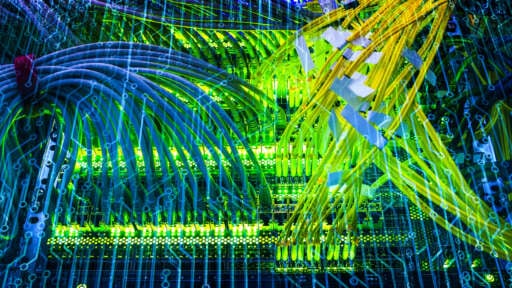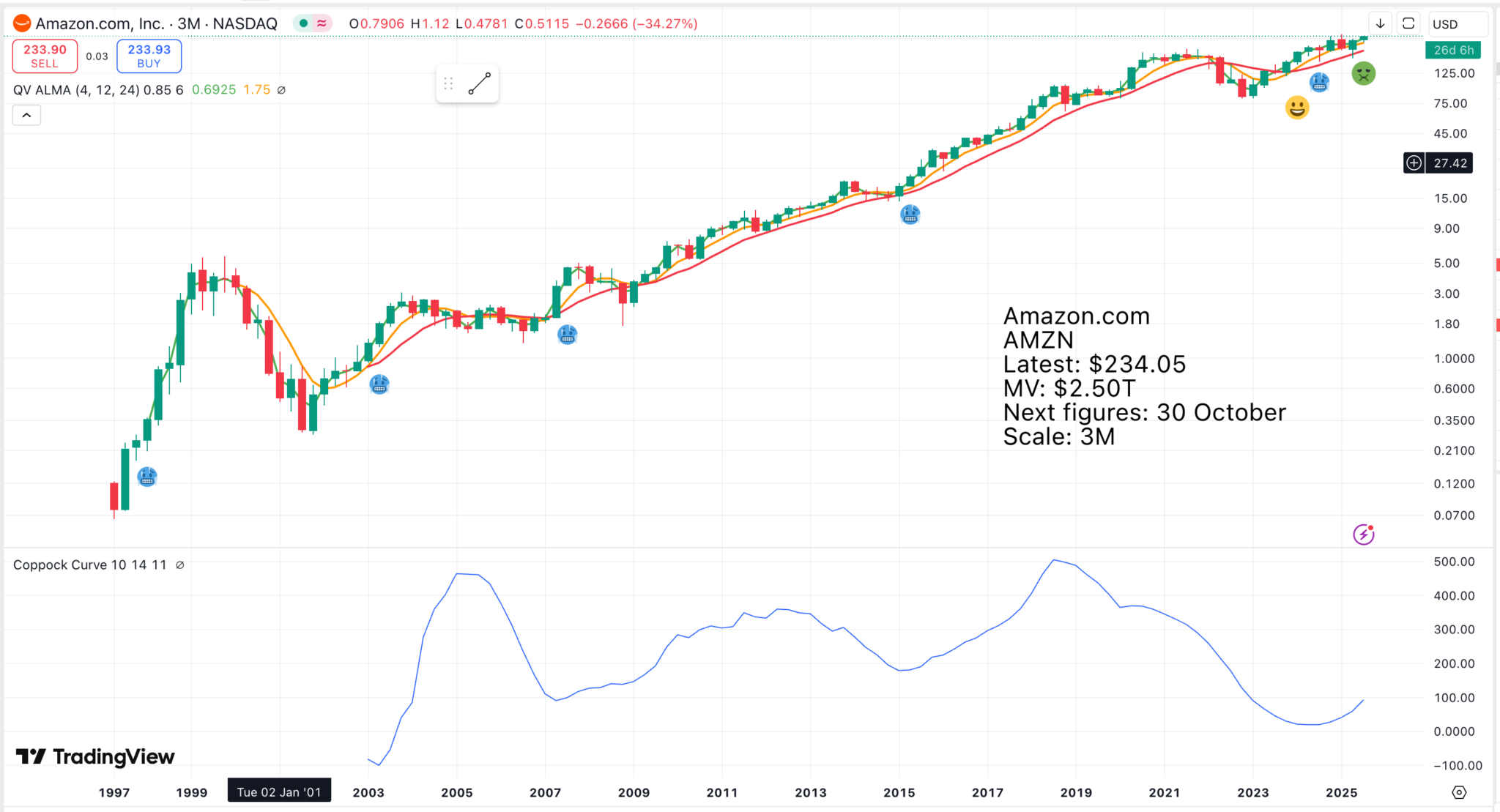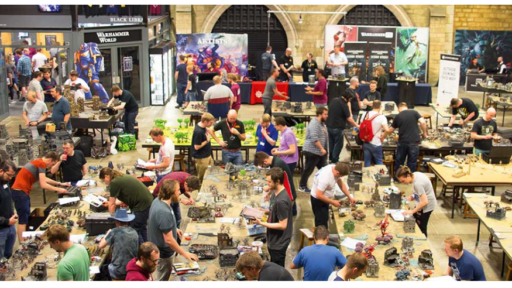
Results from Credo Technology, a developer of networking kit used extensively in data centres, delivered staggering growth for its just-reported Q1 2026 figures. Sales came close to quadrupling from the year earlier.
In the first quarter, we delivered revenue of $223 million, an increase of 31% sequentially and an increase of 274% year over year. Our non-GAAP gross margin was 67.6%, and we achieved nearly $100 million of non-GAAP net income.
Bill Brennan, CEO, Credo Technology, Q1 2026, 3 September 2025
Credo is benefiting from an explosion in demand from the hyperscalers.
Hyperscalers are large-scale cloud providers, such as Amazon Web Services (AWS), Google Cloud, and Microsoft Azure, that operate massive data centers to offer enormous amounts of computing power, storage, and networking resources globally. Their key characteristics are their extreme ability to scale up or down rapidly to meet user demands, their high density of servers, and their provision of extensive, flexible cloud-based services that support everything from data processing and storage to artificial intelligence.
AI Overview, 2025
Credo is in the sweet spot and is taking full advantage.
As hyperscalers and data center operators accelerate investments in AI-driven infrastructure, we provide state-of-the-art solutions for the most demanding connectivity needs, supporting data rates up to 1.6 terabits per second across a range of industry protocols. Credo’s growth has been fueled by strategic partnerships with hyperscalers and key customers, built on our ability to tackle their most complex connectivity challenges. We achieved this by delivering optimized solutions that span the design, development, qualification, and production across our entire product line. Our three-tiered innovation framework comprising of purpose-built Certeus technology, advanced integrated circuit design, and system-level development approach integrates seamlessly with our pilot software and firmware platform, empowering customers to streamline system development and achieve peak performance, yield, and reliability.
Our innovative system-level approach has driven our leadership in pioneering the active electrical cable or AEC market. Looking ahead, we are applying this proven strategy to pursue additional system-level opportunities driven by the demand for better reliability, energy efficiency, and performance. We expect our approach will lead to continued diversification in terms of customers, protocols, and applications. We look forward to announcements over the next several months, including at upcoming trade shows.
Bill Brennan, CEO, Credo Technology, Q1 2026, 3 September 2025
There is a clear hint in this quote that there are exciting announcements ahead. And there is plenty of excitement signalled in this report.
Three hyperscalers each contributed over 10% of our revenue, and we expect our customer diversification to continue to broaden over the upcoming quarters. Based on customer forecasts, we anticipate significant year-over-year growth. While shipment timing may lead to nonlinear growth patterns at a customer level, we see every data center partner scaling their deployments. We’re making strong progress with new customers as well, highlighted by the first material revenue contribution from a fourth hyperscaler in Q1. We anticipate this revenue to grow throughout the fiscal year, further strengthening our market position. The adoption of AECs continues to gain traction across the industry.
And so we’re actually seeing the TAM expanding And I think for the first time in history, that you’re seeing copper replacing optical connections.
Bill Brennan, CEO, Credo Technology, Q1 2026, 3 September 2025
The opportunity is growing with the sales growth.
We also see the trend towards GPU and cluster density to continue to be a catalyst for an expanding AEC TAM. Over the past year, we’ve seen customer interest for AECs expand from inter-rack solutions to rack-to-rack solutions.
Bill Brennan, CEO, Credo Technology, Q1 2026, 3 September 2025
Although a relatively small company, Credo is building a significant moat around its business as the technology advances rapidly.
Advances in liquid cooling and power sourcing have driven a quadrupling of GPU density with one customer, which enables them to architect their entire scale-up network with AECs up to seven meters in length. Reliability and power efficiency led to choosing AECs over optical solutions, as they are up to 1,000 times more reliable and consume half the power. AECs virtually eliminate link flaps, which are intermittent losses of connection, boosting cluster reliability and productivity while reducing power consumption. Our system-level approach drives innovation, accelerates time to market, and delivers a distinct competitive edge.
By owning and delivering the entire solution stack, including SerDes IP, retimer ICs, system-level design, qualification, and production, Credo has forged strong customer relationships and solidified its position as the leader in the AEC market. Moving forward, we’ll continue driving innovation with PCIe AECs and other advanced products coming to market in the near future. Let me now turn to the optical market. During the first quarter, we sustained strong momentum in our optical business, positioning us as on track to achieve our goal of again doubling optical revenue in fiscal 2026. We’re delivering cutting-edge DSP solutions to an expanding roster of optical module customers and their hyperscale end users.
With our expertise in optical DSPs, the rigorous connectivity demands next-generation applications. Our collaborative approach with customers helps ensure solutions that enhance performance, scalability, and power efficiency, further building on our position in the market. We provide customers with a leading-edge portfolio of innovative full DSP and linear receive optical or LRO solutions, supporting port speeds up to 1.6 terabits per second. For several years, the industry has debated the shift from copper to optical connectivity solutions. While consensus holds that copper will remain prevalent in the foreseeable future, Credo is strategically prioritizing optical solutions as a cornerstone of our product roadmap. We see an expanding TAM for both copper and optical connectivity solutions.
Bill Brennan, CEO, Credo Technology, Q1 2026, 3 September 2025
I see Credo Technologies as a small company, by US standards, on the cusp of becoming big.
Over the medium and long term, we anticipate multiple waves of growth opportunities, fueled by the evolving scale-out and scale-up networks and next-generation training and inference architectures. We expect that each of these waves will drive growing demand for innovative connectivity solutions, spanning diverse physical mediums, distances, and protocols. Credo occupies a unique position in the industry as one of the few companies worldwide capable of delivering cutting-edge SerDes technology at the advanced speeds we’re currently qualifying. By combining this core SerDes differentiation, central to our competitive edge, with our integrated circuit expertise and system-level design approach, we deliver solutions optimized to meet each customer’s needs. Credo has become a high-value partner in the unprecedented build-out of hyperscale infrastructure.
I believe our strong results today demonstrate our potential, and I’m increasingly optimistic about the opportunities that lie ahead.
Bill Brennan, CEO, Credo Technology, Q1 2026, 3 September 2025
It doesn’t mean a great deal to me, but for what it is worth, here is a definition of SerDes technology.
SerDes (Serializer/Deserializer) technology converts parallel data into a serial stream for transmission and then converts it back to parallel data at the destination, reducing the number of physical wires and complexity in high-speed communication systems like telecommunications, consumer electronics, and AI networks. By converting multi-lane parallel interfaces into single-lane serial links, SerDes minimizes I/O pins, saves space, and improves signal integrity for faster data transfer over longer distances.
AI OVerview, 2025
The key point about Credo Technology is that they have a fantastic opportunity. The big thing happening in the world today and for the foreseeable future is the build-out of the compute infrastructure to support the global application of ever-smarter AI. The anticipated spend is in the trillions of dollars, and Credo owns technology which is key to this process. The shares may be volatile, but common sense suggests that they are a screaming buy.
The company and hence the shares look set fair for the foreseeable future.
So I think that you know, for us, we just like to see the market go faster sooner. Because the scale-up opportunity represents a significant increase in TAM.
Really, over the next, over the next two to five years.
Bill Brennan, CEO, Credo Technology, Q1 2026, 3 September 2025
Share Recommendations
Credo Technologies. CRDO
Amazon AMZN
Strategy – Fill Your Boots With Credo
One of my theories is that companies have their moment in the sun. Credo and its super-reliable, power-efficient AECs are experiencing just such a moment, and it could last for years, potentially taking the shares much higher than they are today. Setbacks, especially those caused by macroeconomic factors and a general market funk, will present buying opportunities. I would not be surprised if, before this run is over, Credo needs a share split.
I wonder if they could be a takeover target, but any bidder probably needs to act now. I expect Broadcom would love to buy Credo, but probably would fall foul of anti-trust rules.
Here is what AI has to say about Credo.
The AI infrastructure revolution is no longer a speculative narrative—it is a seismic shift reshaping global technology markets. At the heart of this transformation lies Credo Technology (NASDAQ: CRDO), a company whose strategic positioning and proprietary innovations have drawn the attention of analysts like Mizuho Securities, which recently raised its price target for Credo to $135 per share. This 20.54% increase from its previous target underscores a growing conviction that is not just a participant in the AI boom but a critical enabler of the next phase of hyperscaler expansion.
Mizuho’s upgraded price target for CRDO reflects a dual thesis: the company’s technological differentiation and its alignment with the insatiable demand for AI-driven infrastructure. Hyperscalers like, Amazon, Alphabet and xAI are racing to deploy AI servers at unprecedented scales, and Credo’s “n-1” power-efficient technology, Active Electrical Cables (AECs), and optical Digital Signal Processors (DSPs) are uniquely positioned to address the bottlenecks in data transfer between GPUs, CPUs, and storage systems.
The firm’s rationale is bolstered by Credo’s recent financial performance. In Q2 2025, the company reported $170 million in revenue—a 179.6% year-over-year surge—and $0.35 earnings per share, surpassing analyst expectations. Mizuho also highlighted Credo’s potential to add two new hyperscale customers by fiscal 2026, which could further diversify its revenue base and accelerate growth. This upgrade is part of a broader industry-wide optimism, with Mizuho simultaneously raising targets for and signaling a coordinated bullish stance on the AI sector.
Credo’s success hinges on its ability to solve the most pressing challenges in AI infrastructure: power efficiency, scalability, and cost. Its HiWire AECs, for instance, combine retimer, gearbox, and forward error correction in a compact copper format, offering a compelling alternative to traditional optical solutions. These cables reduce power consumption by up to 50% while maintaining high-speed connectivity, a critical differentiator in data centers where energy costs are a major expense.
Equally important is Credo’s SerDes technology, which leverages mature process nodes to deliver high performance at lower costs. By avoiding the complexities and supply chain risks of leading-edge nodes, Credo ensures faster time-to-market and greater reliability. Its Lark 850 optical DSP, which consumes under 10W of power, exemplifies this approach, targeting the high-performance demands of AI data centers without compromising energy efficiency.
The company’s vertical integration—from IP to system-level production—further amplifies its competitive edge. This control allows Credo to iterate rapidly, a necessity in a market where innovation cycles are measured in months rather than years. As hyperscalers like Amazon and Microsoft scale their AI deployments, Credo’s ability to scale alongside them—while maintaining gross margins of 64.77%—positions it as a rare high-margin player in a capital-intensive industry.
In conclusion, Credo Technology is not just a beneficiary of the AI revolution—it is a builder of the infrastructure that will power it. For investors willing to navigate the risks, CRDO offers a compelling opportunity to participate in a market that is redefining the future of computing.
AI Invest, 20 August 2025 (so before the latest incredible results).
Here is what another human analyst had to say.
In an interview with Barron’s after the earnings report, Brennan said Credo is developing system-level optical connectivity solutions that will focus on providing customers better reliability and better power efficiency. He also sees “tremendous opportunity” to win future business inside the six major U.S. hyperscalers.
We “can’t ask for much more than that,” TD Cowen analyst Joshua Buchalter wrote in a note to clients, referring to Credo’s results. “Credo stands to benefit from the exponential growth of data traffic inside the data center … we believe we’re in the early innings of the Credo growth story.”
Credo is a leader in high-speed data connections used in artificial-intelligence data centers. The company offers a variety of products, including optical devices and data networking chips, but its active electrical cables, or AECs, are the most exciting part of its business.
Credo invented the AECs, copper-based cables used to attach AI servers to networking switches. They are more reliable and consume less power than optical cables and can be used over longer distances than traditional passive copper cables can. According to research firm 650 Group, Credo has 73% of the AEC market as of the last reported quarter.
AECs are in the sweet spot right now as the market moves to rack-based servers that have a higher density of graphics processing units. More AECs will be needed to connect the larger AI server clusters. According to Needham, Amazon, Microsoft, and Elon Musk’s xAI are among Credo’s top customers.
Dow Jones Newswires, 4 September 2025
Hot Off The Presses Chart Breakout

Amazon shares are breaking higher from a substantial period of sideways trading. Here is a clue to what may be driving the Amazon share price.
Nowak rates Amazon stock a buy with a price target of 300. But he said the improving growth rate for AWS will be crucial for Amazon shares to rally further.
“AWS’s forward growth and competitive positioning in this early Gen AI era remains the key investor debate and driver of Amazon’s (share price to earnings) multiple,” Nowak wrote. “We believe AWS’s demand backlog remains strong. But in order for these workloads and revenue to flow, AWS still has to work through capacity constraints, which our new analysis suggests AWS is working through … which we view is a positive signal of faster AWS revenue growth ahead.”
Amazon will increase it 2025 capital expenditures dedicated to its Amazon Web Services by a similar total — roughly $33 billion in added spending — as Microsoft’s Azure and Alphabet’s Google Cloud. That’s according to new forecasts from Morgan Stanley’s Brian Nowak. That is a positive signal for the e-commerce giant. Amazon “under-grew” its investments in cloud capacity in comparison to Microsoft in 2023 and 2024, Nowak wrote in a client note.
In cloud computing, capex investments can indicate demand. So-called hyperscalers like AWS and Microsoft Azure invest in building data centers with computing power they can then rent to other enterprises. Nowak noted that Microsoft is still spending nearly double that of AWS on capex when considered as a percentage of total revenue.
“While we see this step up in AWS capex as a bullish indicator of demand to come, we are cognizant of the fact that despite this inflection, overall capex intensity at AWS continues to lag Azure,” Nowak wrote. “This may be due to several factors and is one reason why we expect AWS capex to continue to grow and for capex revisions to likely be skewed to the upside as well, to match forward demand.”
Nowak estimates that Amazon could add 8.5 million square feet of data center capacity this year and 10 million square feet in 2026. That’s roughly even with the pace of 2024 and a step up from previous years, according to the analyst’s note.
Adding that much cloud level of capacity could help accelerate AWS revenue growth to roughly 20% in 2026, Nowak said. That type of growth could help alleviate a key investor concern.
Investors Business Daily, 27 August 2025
The other thing about these technology mega caps, like Amazon, is that there is so much going on inside the companies that investors know little about. Amazon has the scale and the money to do extraordinary things, and it certainly has the ambition. Like millions of people around the planet, I engage with Amazon almost every day, and the same is true of businesses that rely on Amazon for infrastructure services. In the brave new world we are heading into, Amazon will be a key player.



